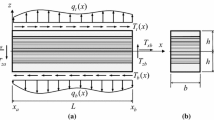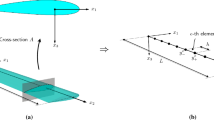Abstract
Anisotropic materials are those that the value of a property depends on the direction of analysis. This article addresses both analytical and numerical stress computation for orthotropic beams under normal and shear loads. The analytical solution is based on potential polynomial functions and the present work establishes general strategies which allow systematic evaluation of the polynomial coefficients. The numerical approximation uses an alternative formulation of finite volumes based on an area weighted average associated with parabolic interpolation functions. The numerical scheme is verified against results obtained for orthotropic beams using both the analytical method and a classical finite volume approximation. Assessment of the global error based on the \(L_2\) norm indicates a high convergence rate and substantially smaller absolute differences when compared to the conventional finite volume approximation.










Similar content being viewed by others
References
Zienkiewicz, O.C., Taylor, L.R.: The Finite Element Method, vol. 1, 5th edn. Butterworth-Heinemann, Oxford (2000)
Lekhnitskii, S.G.: Theory of Elasticity of an Anisotropic Elastic Body. Holden-Day, San Francisco (1963)
Jia, P., Suo, Y., Jia, C.: Elastic solution of stress boundary problem for orthotropic materials. J. Phys.: Conf. Ser. 1637, 012052 (2020)
Hasebe, N.: Analysis of a mixed boundary value problem for an orthotropic elasticity using a mapping function. Int. J. Solids Struct. 208–209, 154–166 (2021)
Hajimohamadi, M., Ghajar, R.: Stress intensity factors for cracks emanating from a circular hole in an infinite quasi-orthotropic plane. Fatigue Fract. Eng. Mater. Struct. 42, 743–751 (2019)
Jia, P., Suo, Y., Jia, C.: General stress field for cracked orthotropic plate. J. Phys.: Conf. Ser. 1622, 012018 (2020)
Hashin, Z.: Plane anisotropic beams. J. Appl. Mech. Trans. ASME 34, 257–262 (1967)
Sankar, B.V.: An elasticity solution for functionally graded beams. Compos. Sci. Technol. 61, 689–696 (2001)
Zhu, H., Sankar, B.V.: A combined Fourier–Galerkin method for the analysis of functionally graded beams. J. Appl. Mech. 71, 421–424 (2004)
Huang, D.J., Ding, H.J., Chen, W.Q.: Analytical solution for functionally graded anisotropic cantilever beam subjected to linearly distributed load. Appl. Math. Mech. 28, 855–860 (2007)
Ding, H.J., Huang, D.J., Chen, W.Q.: Elasticity solutions for plane anisotropic functionally graded beams. Int. J. Solids Struct. 44, 176–196 (2007)
Mascia, N.T., Vanalli, L., Paccola, R.R., Scoaris, M.R.: Mechanical behaviour of wood beams with grain orientation. Mech. Comput. 29, 2839–2854 (2010)
Patankar, S.V.: Numerical Heat Transfer and Fluid Flow, 3rd edn. Hemisphere, New York (1980)
Ferziger, J.H., Peric, M.: Computational Methods for Fluid Dynamics. Springer, New York (2002)
Onate, E., Cervera, M., Zienkiewicz, O.C.: A finite volume format for structural mechanics. Int. J. Numer. Methods Eng. 37, 181–201 (1994)
Cardiff, P., Tuković, H.J., Ivankovć, A.: A block-coupled finite volume methodology for linear elasticity and unstructured meshes. Comput. Sctuct. 175, 100–122 (2016)
Nordbotten, J.M.: Convergence of a cell-centered finite volume discretization for linear elasticity. SIAM J. Numer. Anal. 53, 2605–2625 (2015)
Keilegavlen, E., Nordbotten, J.M.: Finite volume methods for elasticity with weak symmetry. Int. J. Numer. Methods Eng. 112, 939–962 (2017)
Demirdžić, I.: A fourth-order finite volume method for structural analysis. Appl. Math. Model. 40, 3104–3114 (2016)
Demirdžić, I.: Finite volumes vs finite elements. There is a choice. Coupled Syst. Mech. 9, 5–28 (2020)
Cardiff, P., Demirdžić, I.: Thirty years of the finite volume method for solid mechanics. Comput. Methods Eng. (2021). https://doi.org/10.1007/s11831-020-09523-0
Demirdžić, I., Horman, I., Martinović, D.: Finite volume analysis of stress and deformation in hygro-thermo-elastic orthotropic body. Comput. Methods Appl. Mech. Eng. 190(8–10), 1221–1232 (2000)
Cardiff, P., Karač, A., Ivanković, A.: A large strain finite volume method for orthotropic bodies with general material orientations. Comput. Methods Appl. Mech. Eng. 268, 318–335 (2014)
Golubović, A., Demirdžić, I., Muzaferija, S.: Finite volume analysis of laminated composite plates. Int. J. Numer. Methods Eng. 109(11), 1607–1620 (2017)
Fallah, N., Nikraftar, N.: Meshless finite volume method for the analysis of fracture problems in orthotropic media. Eng. Fract. Mech. 204, 46–62 (2018)
Zdanski, P.S.B., Vaz Jr., M., Inácio, G.R.: A finite volume approach to simulation of polymer melt flow in channels. Eng. Comput. 25, 233–250 (2008)
Martins, M.M., Vaz Jr., M., Zdanski, P.S.B.: A note on a derivative scheme for the finite volume method applied to incompressible viscous fluid. Continu. Mech. Thermodyn. 30, 943–952 (2018)
Vaz Jr., M., Muñoz-Rojas, P.A., Filippini, G.: On the accuracy of nodal stress computation in plane elasticity using finite volumes and finite elements. Comput. Struct. 87, 1044–1057 (2009)
Filippini, G., Maliska, C.R., Vaz Jr., M.: A physical perspective of the element-based finite volume method and FEM-Galerkin methods within the framework of the space of finite elements. Int. J. Numer. Methods Eng. 98, 24–43 (2014)
van der Vorst, H.A.: Bi-CGSTAB: a fast and smoothly converging variant of Bi-CG for the solution of non-symmetric linear systems. SIAM J. Sci. Stat. Comput. 13, 631–644 (1992)
Atkinson, K.E.: An Introduction to Numerical Analysis, 2nd edn. Wiley, New York (1989)
Saad, Y.: Iterative Methods for Sparse Linear Systems, 2nd edn. SIAM, Philadelphia (2003)
Higham, N.J.: Accuracy and Stability of Numerical Algorithms, 2nd edn. SIAM, Philadelphia (2002)
Richter, H.G., Dallwitz, M.J.: Commercial Timbers: Goupia glabra Aublet (Cupiuba) (2020). https://www.delta-intkey.com/wood/en/www/celgogla.htm. Accessed 11 Sept 2020
Augarde, C.E., Deeks, A.J.: The use of Timoshenko’s exact solution for a cantilever beam in adaptive analysis. Finite Elem. Anal. Des. 44, 595–601 (2008)
Acknowledgements
The authors acknowledge the financial support provided by the Brazilian funding agency CNPq—(National Council for Scientific and Technological Development), Grant No. 303412/2016-0.
Author information
Authors and Affiliations
Corresponding author
Additional information
Communicated by Andreas Öchsner.
Publisher's Note
Springer Nature remains neutral with regard to jurisdictional claims in published maps and institutional affiliations.
Appendix
Appendix
This Appendix provides the coefficients for \(\phi _p(y)\) of Eq. (14) for a function potential of maximum order \(n=4\), corresponding to a prescribed normal load distribution equation at the beam boundaries with a maximum of second order. The coefficients for equations \(\phi _{n-1}(y)\), \(\phi _{n-2}(y)\), \(\ldots \), \(\phi _{n-4}(y)\) are obtained by back substitution from \(\phi _{n}(y)\), which are jointly determined by using the boundary conditions. The coefficients are as follows:
Coefficients for \(p=n\), \(\phi _{n}(y)= \sum _{k=0}^{3} a_{n}^{k}y^k\) are
Coefficients for \(p=n-1\), \(\phi _{n-1}(y)= \sum _{k=0}^{4} a_{n-1}^{k}y^k\) are
Coefficients for \(p=n-2\), \(\phi _{n-2}(y)= \sum _{k=0}^{5} a_{n-2}^{k}y^k\) are
Coefficients for \(p=n-3\), \(\phi _{n-3}(y)= \sum _{k=0}^{6} a_{n-3}^{k}y^k\) are
Coefficients for \(p=n-4\), \(\phi _{n-4}(y)= \sum _{k=0}^{7} a_{n-4}^{k}y^k\) are
Rights and permissions
About this article
Cite this article
Rebello, M.A., Zdanski, P.S.B. & Vaz, M. Considerations on alternative solutions for stress analysis of anisotropic materials: a beam case study. Continuum Mech. Thermodyn. 33, 2123–2140 (2021). https://doi.org/10.1007/s00161-021-01012-4
Received:
Accepted:
Published:
Issue Date:
DOI: https://doi.org/10.1007/s00161-021-01012-4




